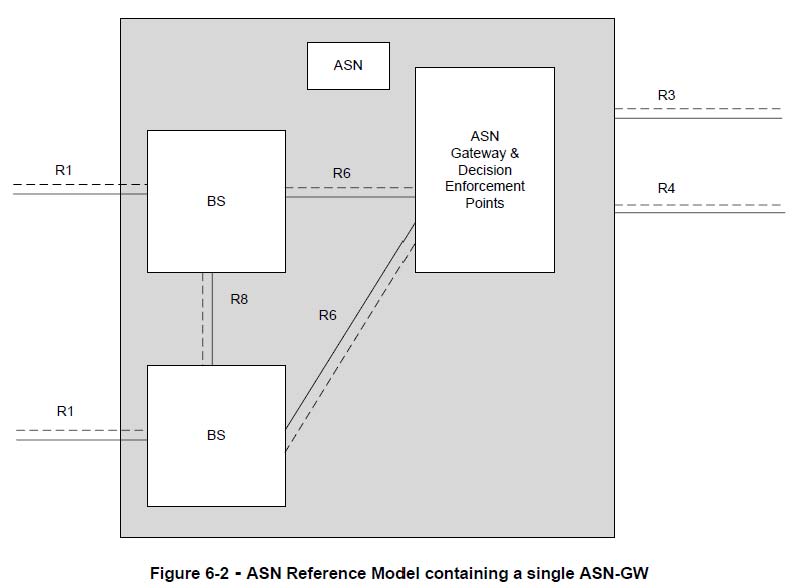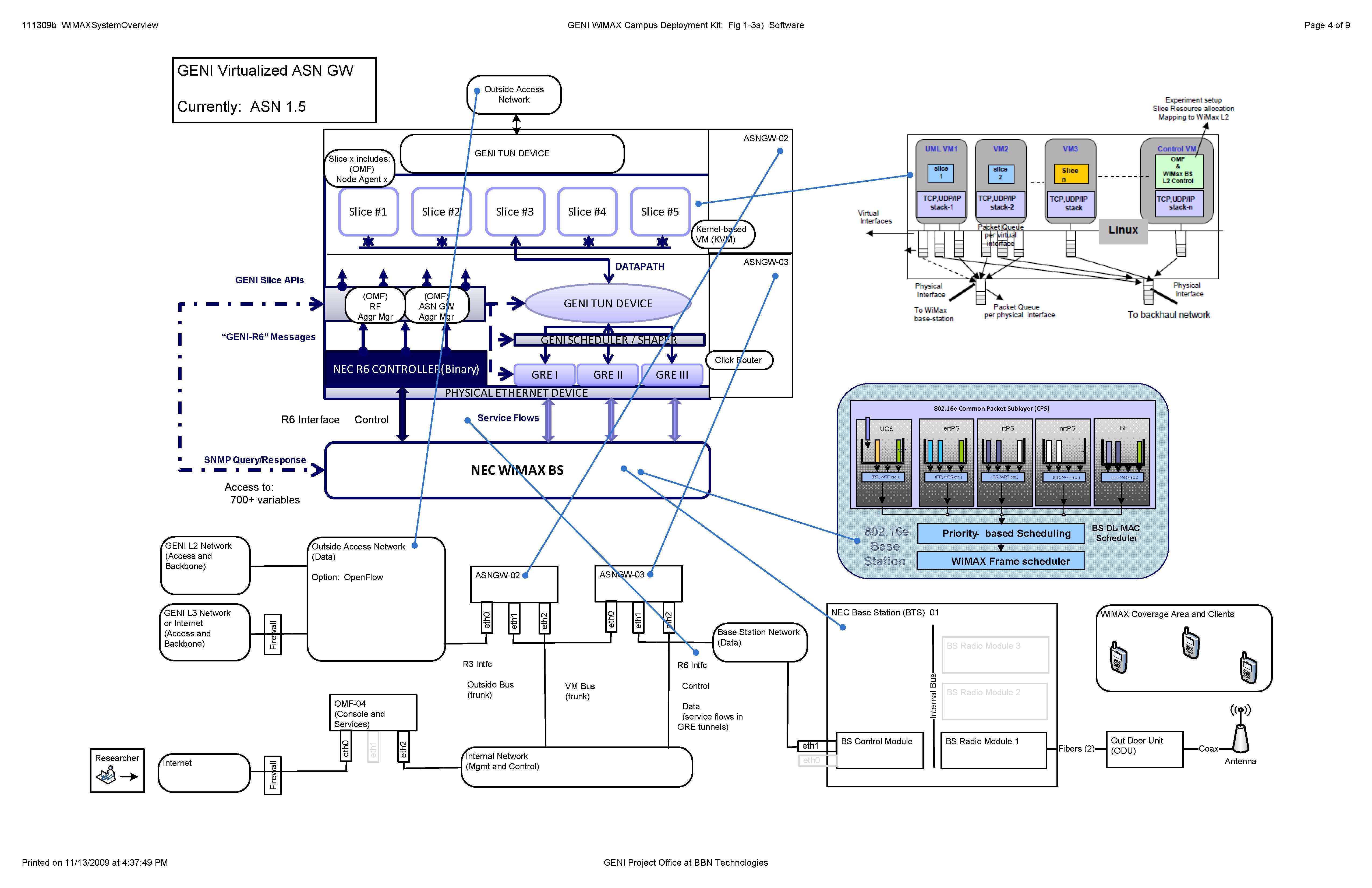| Version 215 (modified by , 13 years ago) (diff) |
|---|
-
WiMAX Meso-Scale Deployment Integration
- 1. Projects
- 2. Meetings and Demos
- 3. References and Documents
- 4. System Engineering
- 5. GENI D&P WiMAX Infrastructure Buildout
-
6. WiMAX Campus Deployment Kit
- 6.1 Configuration
- 6.2 Base Station Hardware
- 6.3 WiMAX Antenna
- 6.4 GPS Antenna
- 6.5 -48VDC Power
- 6.6 Server Hardware
- 6.7 Software Modules
- 6.8 Messages and APIs
- 6.9 Virtualization
- 6.10 Control and Management
- 6.11 Backbone Network Access
- 6.12 Federation
- 6.13 Monitoring and Management
- 6.14 Kit Bill of Materials
- 6.15 Kit Software
- 6.16 Kit Integration and Delivery
- 6.17 Kit Issues
- 7. WiMAX Client Platform Kit
- 8. WiMAX Campus Installation and Deployment
- 9. WiMAX Base Station Configuration
- 10. WiMAX Base Station Software Installation, Configuration and Operation
- 11. WiMAX Mobile Station Configuration
- 12. WiMAX Site Federation
- 13. WiMAX Site Operations and Management
- 14. WiMAX Experiments and Demos
WiMAX Meso-Scale Deployment Integration
1. Projects
Campus deployment projects:
WiMAX at Columbia University
WiMAX at Polytechnic Institute of NYU
WiMAX at UCLA
WiMAX at University of Colorado at Boulder
WiMAX at UMass Amherst
WiMAX at University of Wisconsin
WiMAX at BBN Technologies
Open GENI WiMAX Base Station Kit for Campus Deployments
WIMAX Design and Prototype
ORBIT Design and Prototype
OMF (cOntrol and Management Framework)
ORBIT Testbed
GENI Projects at WINLAB
Process for updating Milestones, submitting QSRs
2. Meetings and Demos
Suggested mailing lists for Cluster E and WIMAX Integration participants:
GENI mailing lists, including the dev, discuss and geni-announce lists, plus working groups that cover your interests.
mail to cluster-e-admin@winlab.rutgers.edu for PIs. / subscribe / mailman archieve
mail to cluster-e-user@winlab.rutgers.edu for users / subscribe / mailman archieve
mail to wimax-developer@email1.winlab.rutgers.edu for developers (PIs. and others) / subscribe / mailman archieve
mail to wimax-experimenter@email.orbit-lab.org for experimenters / subscribe / mailman archieve
WiMAX Base Station Demo at GEC 6, November 17, 2009
Cluster E and WiMAX Deployment Call on February 8, 2010
Cluster E and WiMAX Deployment Call on March 1, 2010
Cluster E and WiMAX Deployment Meetings at GEC7 March 16 and 17, 2010
Cluster E and WiMAX Demo Plans for GEC8 and GEC9
Cluster E and WiMAX Deployment Meeting at GEC8 July 20, 2010
Cluster E and WiMAX Deployment Meeting at GEC9 November 2, 2010
WiMAX ParkNet Demo at GEC9 November 3, 2010
Cluster E and WiMAX Deployment Call on January 5, 2011
Cluster E and WiMAX Deployment Call on January 27, 2011
Cluster E and WiMAX Deployment Call on February 23, 2011
Cluster E and WiMAX Deployment Meeting at GEC10 March 17, 2011, 9am - 10:30am
3. References and Documents
WiMAX Forum
WiMAX Forum Technical Specifications
WiMAX Forum Network Architecture Release 1.0 Version 4 - Stage 2: Architecture Tenets, Reference Model and Reference Points
WiMAX Forum: "Mobile WiMAX – Part I: A Technical Overview and Performance Evaluation", March 2006
WiMAX Forum: "Mobile WiMAX – Part II: A Comparative Analysis", May 2006
GENI WiMAX Project: System Engineering Summary
API Specification for Virtualized WiMAX Basestation
D. Raychaudhuri and Editors M. Gerla, “New architectures and disruptive technologies for the future internet: The wireless, mobile and sensor network perspective” Report of NSF Wireless Mobile Planning Group (WMPG) Workshop, August 2005
Open Base Station Architecture Initiative
“Android: An Open Handset Alliance Project"
”NEC’s broadband wireless access products”, NEC Corporation Technical White Paper
“Wireless virtualization in GENI”, GDD-06-17, 2006
- Paul, R. Yates, D. Raychaudhuri and J. Kurose, "The Cache-and-Forward Network Architecture for Efficient Mobile Content Delivery Services in the Future Internet", to appear in ITU-T Next Generation Networks (NGN) Conference, Geneva, May 2008.
OMF (cOntrol and Management Framework)
ORBIT Testbed
Current OMF documents
Cluster E Overview Drawing
ORBIT diagram
WiMAX connectivity from WINLAB follows ORBIT connectivity
ORBIT Connectivity
OML is a measurement library developed in the context of OMF.
OML Overview (wiki)
OML Overview (slides)
Tutorial on WiMAX Setup Using OMF (slides)
4. System Engineering
4.1 WiMAX Standards
Ongoing WiMAX standards work is done by the WiMAX Forum. See, for example, the WiMAX Forum Technical Specifications
4.2 WiMAX Network Architecture
An technical overview of WiMAX network architecture is presented in WiMAX Forum Network Architecture Release 1.0 Version 4 - Stage 2: Architecture Tenets, Reference Model and Reference Points, including:
Fig 6-1) Network Reference Model
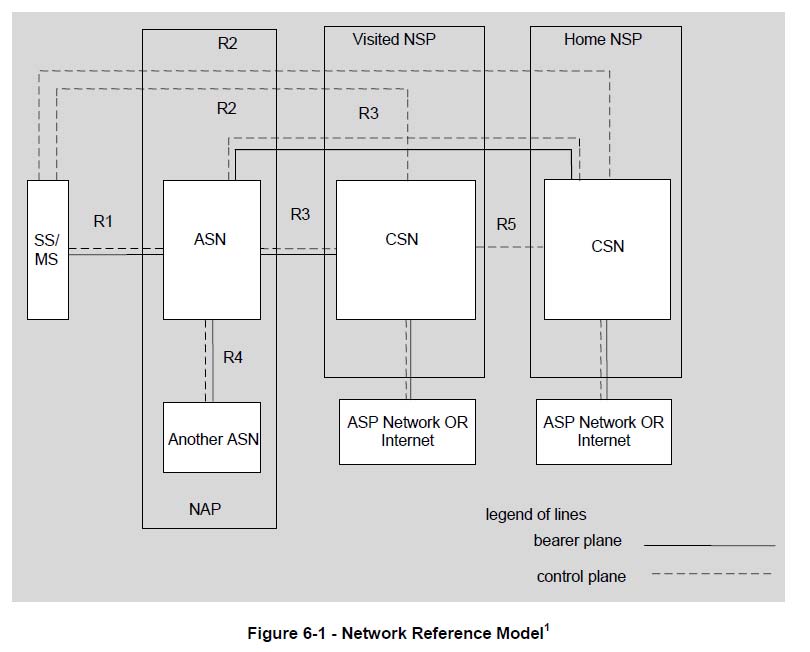
4.3 GENI WiMAX Project Technical Overview
A technical overview of the GENI WiMAX project is presented in: GENI WiMAX Project: System Engineering Summary.
The GENI WiMAX project currently utilizes commercial NEC WiMAX equipment as the basis of its WiMAX campus deployment kit, including a Profile A Base Station and a separate ASN Gateway, joined by the R6 interface, per Figure 6-2, above. The R6 interface implementation is not fully standardized, and thus includes NEC-specific functions.
For the GENI WiMAX project, the WiMAX campus deployment kit provides the GENI Researcher with much flexibility:
The use of a Profile A Base Station with an exposed R6 interface enables the researcher to monitor and control the base station radio functions.
The ASN gateway utilizes some essential NEC code, but removes many high-level WiMAX functions (e.g., roaming) and allows the researcher to implement their own.
Finally, the ASN gateway includes slicing functions, to allow the base station and ASN gateway to be shared by multiple researchers at the same time.
Later in 2010, NEC will be updating their WiMAX equipment to utilize a Profile C Base Station, where some of the current ASN gateway functions are included in the Base station, and fully standardized R6 interface is exposed. When this occurs:
The current GENI-specific ASN gateway software will have to be modified, with an effort of at leat 2 MM.
The researcher will have diminished ability to monitor and control the base station radio functions.
4.4 GENI WiMAX Base Station Range and Capacity
Need to be able to estimate the expected range and capacity of a completed installation, and how this varies with antenna height, to guide each campus in their planning. Also, how this varies depending on the number of clients and their data rates.
Then, need to verify estiamtes with measurements at various sites.
Ivan Seskar: Have some data from Rutgers WINLAB site, and expect more when Rutgers Bush Campus site is in service. Can configure split between downstream and upstream. With 10MHz bandwidth, limited to approximately 20Mbps total. Have seen range approximately x10 of WiFi range. Have seen downstream of 2+Mbs at 2km combined with 7Mbs at short distances.
Ray Raychaudhuri on 3/16: Expect standard range information from NEC in 2+ weeks.
Max Ott on 3/16: Should consider planning tools seen at 3G trade shows, to estimate ranges.
Tony Michel on 3/30: Preparing plan to measure base station range and capacity at BBN Technologies site, starting with initial checkout.
Harry Mussman on 4/30: WiMAX Forum document on WiMAX Forum: "Mobile WiMAX – Part I: A Technical Overview and Performance Evaluation", March 2006 provides good information on range and capacity, including Dl and UL link budgets for a nominal case.
4.5 System Engineering Issues
| No | Issue | Who | Opened | Resolved | Resolution | Note |
| 4.1 | "GENI Operator ID": Each WiMAX deployment requires an Operator ID (OpID), a parameter used within the base station and each client. Currently, Routgers WINLAB is using the Sprint/Clearwire ID, but this can only be temporary. We need to apply for and receive a "GENI Operator ID". | Agosain | 2/23/10 | 4/30/10 | From IEEE: company_id is: 4451DB16, represented as a conventional 6-digit hexadecimal integer. Tutorials to help implement the use of the I.D. assignment Basis for the IEEE 802-2001 tutorial | Per Seskar, apply at IEEE 802.16 site. Fee is $1650. |
| 4.2 | Range and capacity: Need to be able to estimate the expected range and capacity of a completed installation, and how this varies with antenna height, to guide each campus in their planning. Also, how this varies depending on the number of clients and their data rates. Then, need to verify at sites, | Michel, Seskar, Rangarajan, Mussman | 2/23/10 | - | - | On 3/16: Expect standard range information from NEC in 2+ weeks. Ott on 3/16: Should consider planning tools seen at 3G trade shows, to estimate ranges. Michel on 3/10: Preparing emasurement plan. On 4/30: See WImAX Forum Technical Overivew document. |
| 4.3 | GPS receiver: NEC documentation shows a GPS receiver mounted along with the antenna, and connected to the NW INTFC on the IDU. It provides precise timing signals to the base station. | Seskar, Mussman | 2/23/10 | 2/23/10 | Agreed to include in the kit, since total cost is likely to be less than $125, and it should be installed at the start. | Next: Need to engineer active antenna and cable for up to 100m; see Kit Issues |
| 4.4 | "GENI PKI Certificate": If we want to do over-the-air provisioning to clients, we will require a PKI certifiacte signed by Verisign, that clients can verify (per Seskar). | Michel, Agosain | 2/23/10 | - | - | Need to decide how GENI would use this; if worthwhile, then plan process to obtain one. |
| 4.5 | - | - | - | - | - | - |
5. GENI D&P WiMAX Infrastructure Buildout
5.1 GENI WiMAX Buildout Plan
The overall GENI buildout plan is funded by an NSF contract, and is summarized in GENI D&P WiMAX Infrastructure Buildout.
It includes a map of the participating campuses:

And a list of involved researchers and IT leaders:
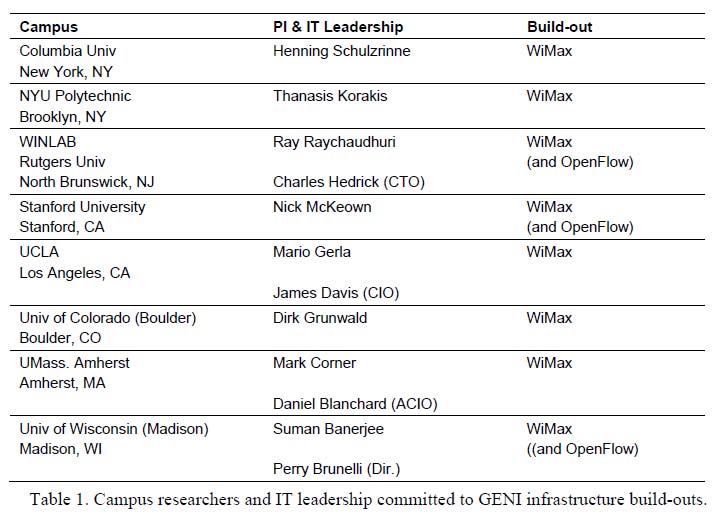
5.2 GENI WiMAX Usage Plans
The WiMAX Kit Project (1753) outlined the usage plans for each campus:
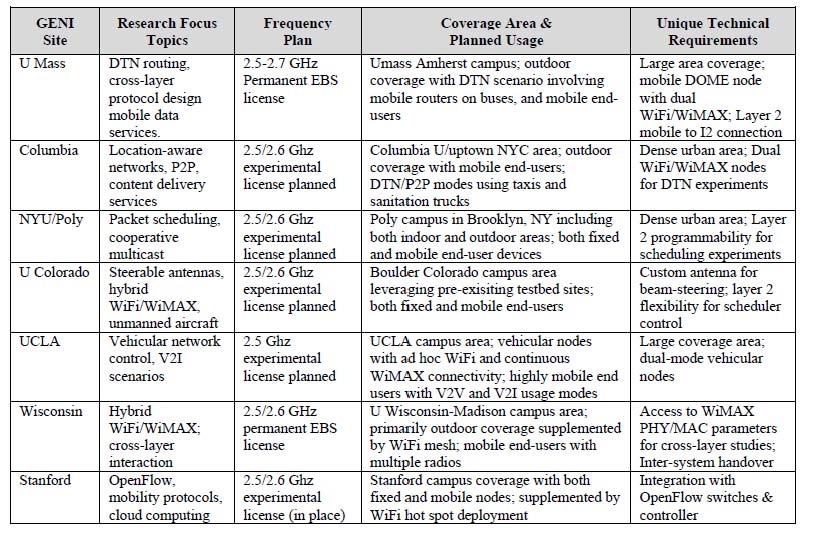
Each project has been reviewing and updating their plans for research, which will help drive design of kit and software. See Section 11, "WiMAX Experiments and Demos".
5.3 GENI WiMAX Kits
As part of the Spiral 1 WiMAX D&P prject, two WiMAX campus deployment kits were purchased for:
Development at Rutgers, WINLAB
Service at Rutgers, WINLAB
The following campuses/sites purchased their own kit:
NEC Labs America
Stanford
The WiMAX Kit Project (1753) is purchasing and supplying WiMAX campus deployment kits to the following campuses. In addition, it is providing a limited number of client platform kits.
Rutgers, Bush Campus
Columbia University
Polytechnic Institute of NYU
UCLA
University of Colorado at Boulder
UMass Amherst
University of Wisconsin
The following GENI-related campuses/sites are purchasing the necessary equipment to build their own WiMAX campus deployment kits, and then deploying them with aid from the GPO and Rutgers WINLAB:
BBN Technologies, Cambridge, MA
University of Wisconsin, 2nd site
The following campuses/sites have indicated an interest in obtaining their own WiMAX campus deployment kits:
University of North Texas (Prof Kamesh Namuduri on 3/16)
Florida International University
UC San Diego (Prof B. S. Manoj)
Wayne State University (Prof Hongwei Zhang)
NC State (Porf Rudra Dutta)
Ray Raycaudhuir on 3/16: Would prefer to get existing deployment underway, and then consider a 2nd round of kits beginning in 5+ mo.
New kits would be Profile C
Expect NEC would like to see orders for 40-50, if possible
5.4 GENI WiMAX Licenses
Each GENI WiMAX campus/site must have a valid FCC license to operate a WiMAX base station. In some cases, a campus/site plans to use an existing "educational license" already held by their institution. However, in most cases, the campus/site plans to apply for and use a new "experimental license" that, by and large, can be obtained just by requesting it from the FCC. This process has been successful in 6 cases for 5 campuses/sites. See Section 8.2, "Obtain FCC License".
However, in almost all situations, there is a potential overlap with the ongoing national Clearwire/Sprint WiMAX rollout. (See the list of current and planned deployments below.) This is true for several reasons.
If a GENI WiMAX campus/site plans to use an existing "educational license" already held by their institution, which has not yet been leased to Clearwire/Sprint, there is a reasonable chance that the institution may yet pursue a lease with Sprint/Clearwire, and thus the GENI WiMAX campus/site could lose their license.
In the cases where the institution has leased their "educational license" to Clearwire/Sprint (which may or may not have started service), all is not lost. A new upcoming rule apparently requires that an institution that has leased their "educational license" must retain "at least 5%" for their own use, or else forfeit their license. So, a GENI WiMAX campus/site may gain partial access to an "educational license" even if it has alreasy been leased to Clearwire/Sprint.
In the cases where a GENI WiMAX campus/site plans to apply for and use a new "experimental license", it has been found that most available spectrum has been leased to Sprint/Clearwire, although they are not yet using it in most locations (see below). So, the FCC will grant an "experimental license" that overlaps spectrum already leased (likely to Clearwire/Sprint), but they require: if the owner of the spectrum (i.e., Clearwire/Sprint) begins service, the holder of the "experimental license" must stop using the spectrum immediately.
So, what does this all mean?
1) If a GENI WiMAX campus/site uses an "educational license" already held by their institution (or "5% of one", by the upcoming rule), they are OK (unless the institution decides to lease the license).
2) If a GENI WiMAX campus/site uses an "experimental license" that does NOT overlap a license holder, they are OK.
3) If a GENI WiMAX campus/site uses an "experimental license" that DOES overlap a license holder, they are OK UNTIL that license holder (i.e., Clearwire/Sprint) decides to start using that spectrum, and then they will have to shut down their WiMAX base station. This is a significant concern in major metropolitan areas, per the deployment plans listed below.
However, this could change. An NSF effort is beginning to define a Wireless National-scale Test Bed (WiNTeB); this could possibly affect the allocation of spectrum to national testbed uses.
Another possible strategy has been identified by Tony Michel. In at least three locations, (Boston, Sussex Cty, MA; Brooklyn, Kings Ct, NY; Manhattan, NY Cty, NY) he has identified a 5-MHz slice of specturm in the educational band with no assigned licenses.
BBN technologies has applied for and been granted an experimental license for the 5-MHz slice in Sussex County.
PIs at NYU Poly and Columbia are in the process of appplying for experimental licenses for the 5-MHz slices in their counties.
Assuming that both NYU Poly and Columbia are grnated experimental licenses in their respective 5-MHz slices (smae frequencies, but geographically separated), then the NYU Poly and Columbia institutions should be able to apply for and be granted full educational licenses in the slices. What does this mean?
4) If so, NYU Poly and Columbia would be able to use full educational licenses without challenge from Sprint/Clearwire or any other commercial enterprises.
Clearwire/Sprint Deployments
See 2009 rollout
See 2010 plans
+ Currently in service (June, 2010):
- Georgia, Atlanta and more
- Maryland, Baltimore
- Illinois, Chicago
- Nevada, Las Vegas
- Oregon, Portland and Salem
- North Carolina, Charlotte, Greensboro and Raleigh
- Hawaii, Honolulu and Maui.
- Texas: Abilene, Amarillo, Austin, Corpus Christi, Dallas, Fort Worth, Houston, Killeen/Temple, Lubbock, Midland/Odessa, San Antonio, Waco and Wichita Falls
- Washington, Seattle and more
- Idaho, Boise
- Missouri, St. Louis and Kansas City
- Pennsylvania, Philadelphia and more
- Central Washington, D.C.
+ Planned for remainder of 2010:
- Massachusetts, Boston
- Colorado, Denver
- Oregon, Eugene
- New York, New York City, Syracuse and Rochester
- California, San Francisco bay area, Los Angeles, Merced, Visalia, Modesto, and Stockton
- Washington, Yakima
- Minnesota, Minneapolis
- Delaware, Wilmington
- Michigan, Grand Rapids
- Florida, Miami
- Ohio, Cincinatti and Cleveland
- Pennsylvania, Pittsburg
5.5 GENI WiMAX Buildout Issues
| No | Issue | Who | Opened | Resolved | Resolution | Note |
| 5.1 | Who wants additional kits: We need to compile a list of GENI-related campuses and sites that want to purchase the necessary equipment to build their own WiMAX campus deployment kits. | Mussman | 12/09 | 3/16/10 | BBN and 2nd for Wisconsin going ahead; U Norht Texas and FIU waiting. | |
| 5.2 | How to order additional kits: We need to understand how to order the key components from NEC for a WiMAX campus deployment kit, both BofM and process. | Rangarajan | 2/10 | 3/5 | Sent info to order | |
| 5.3 | Research plans: Each project should review and update their plans for research, which can help drive design of kit and software. | All | - | 3/16, ongoing | See Section 11 | - |
| 5.4 | Spares: Currently, there are no designated spares for hardware that could fail: ODU, NW INTFC card or CHC card. What will we do if we need a spare? | Rangarajan, Mussman | 2/23/10 | 3/1 | There will be a few spares at WINLAB and NEC America | |
| 5.5 | - | - | - | - | - | - |
6. WiMAX Campus Deployment Kit
6.1 Configuration
A full WiMAX testbed system configuration utilizes three servers, per Figure 1-2a):
ASNGW-C, that provides combined ASN GW functions, and includes a CLICK router.
ASNGW-V, that provides virtualized ASN GW functions, for separate slices, with one VM assigned to each slice.
OMF, that provides a full set of OMF/OML functions.
All servers run ubuntu Linux, and the ASNGW-V server implements kvm virtualization.
Fig 1-2a) WiMAX Testbed System Configuration with Three Servers
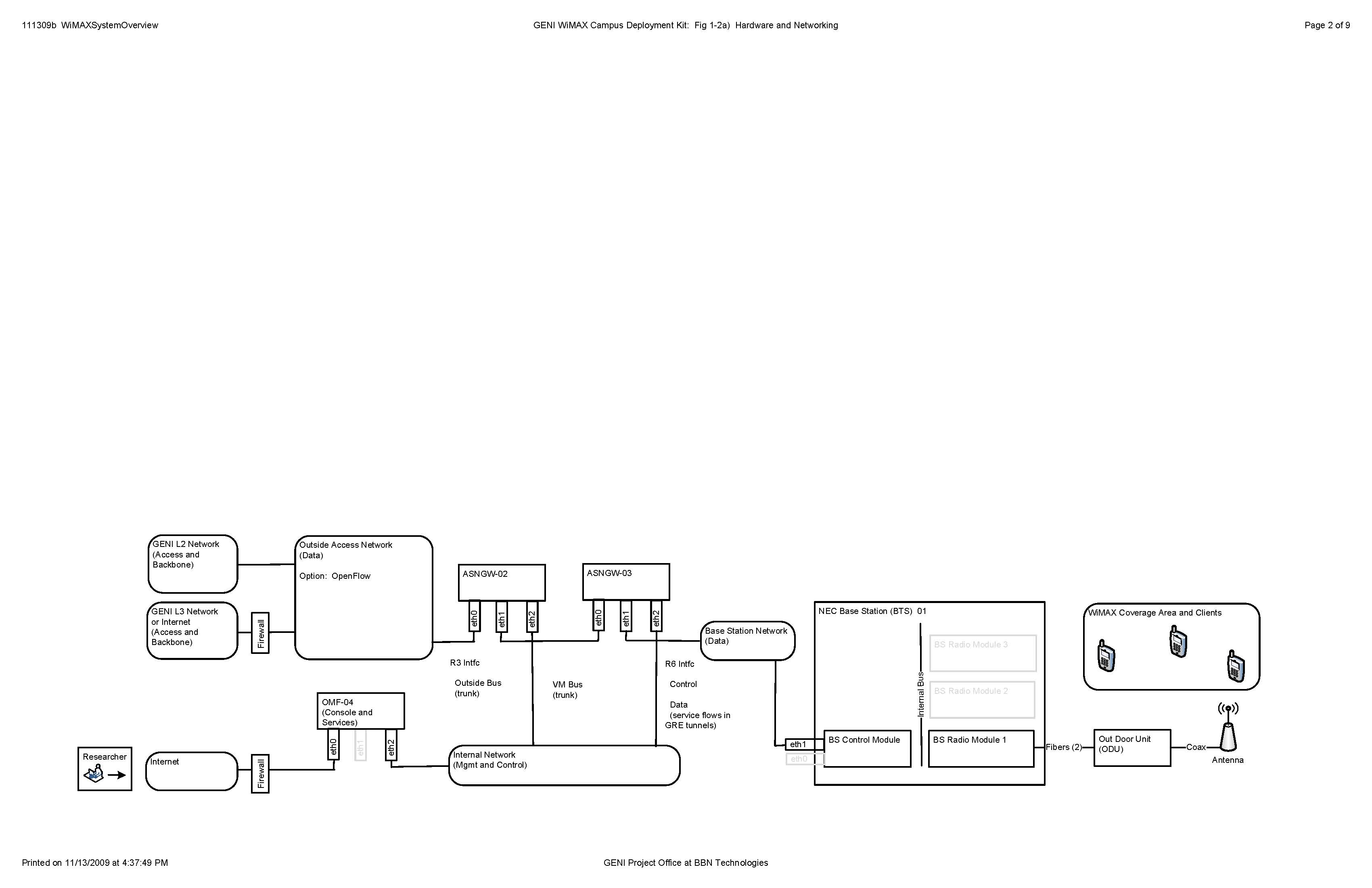
In some cases, it should be possible to combine the ASN GW functions into one server, for a WiMAX testbed system configuration that utilizes two servers, per Figure 1-2b).
ASNGW, that provides all ASN GW functions OMF, that provides a full set of OMF/OML functions.
Both servers run ubuntu Linux, and the ASNGW server implements kvm virtualization, with the combined ASN GW functions (non-virtualized) running in Dom0.
In some cases, a campus already has a set of OMF/OML functions, and would likely not require the OMF server:
Rutgers, WINLAB
Rutgers, Bush Campus
Polytechnic Institute of NYU
Fig 1-2b) WiMAX Tetsbed System Configuration with Two Servers

Finally, in many cases, it should be possible to combine all funtions within one server, for a WiMAX testbed system configuration that utilizes one server, per Figure 1-2c).
ASNGW-OMF that provides all ASN GW and OMF/OML functions.
This server runs ubuntu Linux, and implements kvm virtualization, with the combined ASN GW (non-virtualized) and OMF/OML functions running in Dom0. Note that this server must have a total of four ethernet ports to provide all of the required conenctivity.
When this configuration uses a high-capacity (i.e., dual-CPU) server, it should have sufficient capacity for most installations. Thus, it is the configuration that will be used for the initial installations at all campuses/sites.
Later, additonal servers can be added as necessary for capacity. For example, if specialized functions such as video coding were included in a slice's VM, then additional capacity may be required.
Fig 1-2c) WiMAX Testbed System Configuration with One Server

6.2 Base Station Hardware
The NEC BTS base station hardware includes the following units, ashown in Figure 1-2d:
- OutDoor Unit (ODU), bolted to a pole near the WiMAX antenna, and connected via a coax to the WiMAX antenna.
- InDoor Unit (IDU), rack mounted in an equipment room, connected via a dual fiber cable to the ODU.
For installation details, see NEC Installation Manual for Base Station (IMN:BS)
Fig 1-2d) NEC BTS IDU and ODU Base Station Hardware
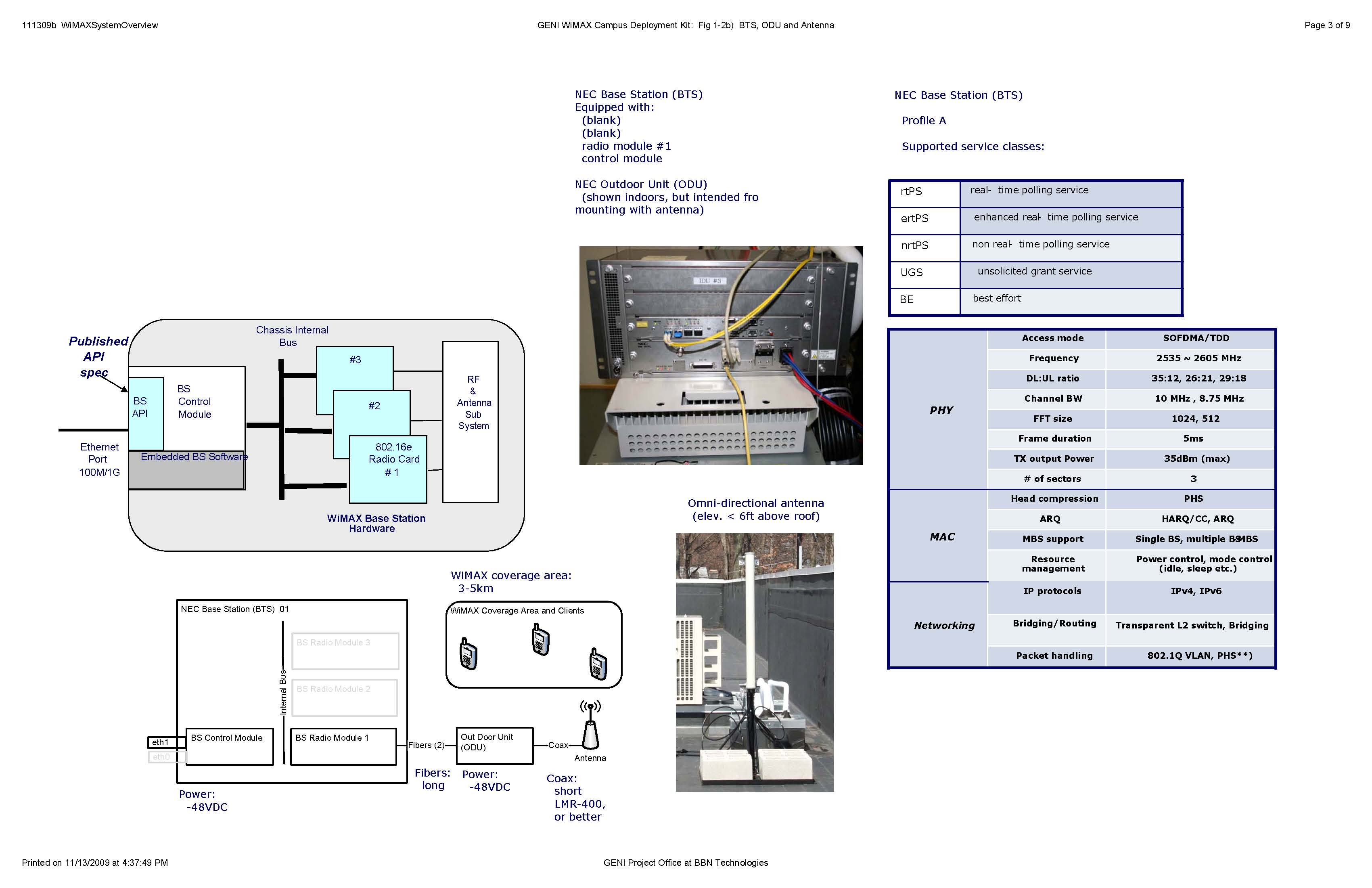
6.3 WiMAX Antenna
There are three types of 2.6GHz WiMAX antennas that may be installed at the site:
- NEC 120-degree sector antenna, provided by Rutgers as part of the kit. See NEC Sector Antenna Installation Manual
- Commercial 2.6GHz 360-degree omni-directional pole antenna, not provided by Rutgers as part of the kit
- Commercial 2.6GHz 30-degree directional patch antenna, not provided by Rutgers as part of the kit
Each campus should decide on the appropriate antenna (or antennas), for thier planned experiments and their local topography.
The antenna must be connected to the NEC ODU using a short length of low-loss cable, with N-type connectors:
- LMR-400-series cables with N-type connectors, with 0.68 dB loss for 10 feet
- LMR-600-series cables with N-type connectors, with 0.44 dB loss for 10 feet; recommended for long runs
Typical WiMAX cable components are:
- N-male to N-male cable, 2 feet in length.
- N-male to N-male cable, 4 feet in length.
- N-male to N-male cable, 10 feet in length.
- N-female to N-female connector, to join two cables with N-male connectors.
Note that the loss in the cable can have a significant impact on range.
It should be possible to include two (or more) antennas, and move the coax cable between antennas to select the antenna in use.
As an alternative, a coaxial relay switch can be mounted in a wether-tight box on the roof (see below), and used to remotely select the antenna in use.
6.4 GPS Antenna
A GPS antenna is mounted on the roof and connected to the IDU to provide a stable and precise timing source to the base station.
The GPS antenna can be mounted in any outdoor location where it can "see" the sky, but it is typically mounted in the same location as the WiMAX antenna.
The suggested GPS antenna is the PCTel GPS-TMG-SPS-40NCB timing reference antenna. It provides:
- integrated lightning protection
- heavy duty mounting clamp
- amplifier with 40 dB of gain
The GPS antenna is connected to the NEC IDU using a 50-ohm coax, that carries the received signal to the IDU, and power to the antenna assembly. Connectors are:
- NEC IDU: GPS Antenna Terminal (GPS ANT): BNC connector
- GPS antenna: N, female (one - bottom fed)
The suggested 50-ohm coax cable is RG58C/U, which has a loss at the GPS frequency of approxiamately 1000MHz of 40 dB for 200 ft of cable. The amplifier with 40 dB of gain compensates for this loss.
Typical GPS antenna cable components are:
- BNC-male to BNC-male cable, multiple lengths.
- BNC-male to BNC-male cable, 200 ft length.
- BNC-female to BNC-female connector, to join two cables with N-male connectors.
- BNC-female to N-male connector, to join a BNC-male cable to the GPS antenna assembly
6.5 -48VDC Power
Both the NEC ODU and IDU are, as telecom systems, powered by a -48VDC power source. Power feed connections are outlined in the NEC Installation Manual for Base Station (IMN:BS)
It is recommended that two separate -48VDC power supplies, with 110VAC feeds, be provided, one for each unit. This avoids the need for a -48VDC distribution panel, with circuit breakers, and yet still allows individual control for each unit.
The power supply for the ODU is typically mounted indoors, with the indoor testbed equipment. Optionally, it can be mounted in a weather tight box on the roof (assuming a 110VAC supply is avaialble on the roof).
The typical configuration for powering the ODU is:
- ODU mounted outdoors, on roof, with maximum of 4A required at -48VDC
- One 10m (approx 30ft) outdoor power cable, two conductors, 12AWG, rated for outdoor use, with ODU Circular Connector, soldered onto cable.
- Lightning surge protector mounted on a barrier terminal block in a weather tight box on the roof.
- Additional outdoor power cable, two conductors, 12AWG, rated for outdoor use, for connection between the roof and the power supply mounted in the equipment room.
- One power supply for ODU, Mean Well SP-200-48, 110VAC input, -48VDC output, rated 4.2A or 200W, mounted in the testbed equipment room.
Typical outdoor cable:
The typical configuration for powering the IDU is:
- IDU mounted indoors, in testbed equipment room, with maximum of 8.4A required at -48VDC (in full configuration with all 3 sector boards).
- One 10m (approx 30ft) indoor power cable, two conductors, 10AWG, with one IDU Rectangular Power Connector and four IDU Rectangular Power Connector Contacts , two for each of the positive and negative DC power rails, crimped onto cable with a special tool, or soldered.
- One power supply for IDU, Mean Well SP-320-48, 110VAC input, -48VDC output, rated 6.7A or 320W, mounted in tesbed equipment room.
6.6 Server Hardware
Per Section 6.1, the system can be configured with as many as three servers, but will be configured with one server for initial bringup, per Figure 2-1c).
The recommended server hardware for the one-server configuration is:
6.7 Software Modules
6.8 Messages and APIs
6.9 Virtualization
Ivan on 3/16: One server uses kvm virtualization, with one VM per slice.
Use VLAN tags to identify flows between servers.
Expect to use Best Effort (BE) queue in WiMAX base station, so that can individually control flows in ASN GW.
Giovanni: Prefers zen for virtualization, since lightweight.
Max: Likes kvm virtualization, since easy to setup.
6.10 Control and Management
Control and management of each WiMAX testbed will be done via OMF; see Figure 1-5):
Fig 1-5) Control and Management

6.11 Backbone Network Access
Each WiMAX testbed must be connected to a L2 and/or L3 backbone network to handle experiment data flows; see Figure 2-1a). The VLANs associated with each slice must be switched to the appropriate backbone VLAN, or to the backbone L3 network.
The Rutgers WINLAB testbed has been connected to the Internet2 backbone network, and has used the ION service to extend L2 (VLAN) connections to the NICTA and BBN testbeds. Thus, Internet2 is the preferred backbone for all WimAX testbeds.
6.12 Federation
During initial bringup, each WiMAX testbed will operate as a self-contained OMF-controlled testbed.
Then, various WiMAX testbeds will be federated, by:
Connecting the Management and Control Networks of the testbeds together using a multipoint VLAN provided by the GENI backbone, to permit coordinated OMF control of two or more testbeds by one experimenter.
Connecting experiment data from testbeds together, using a VLAN carried by a GENI backbone.
See Section 9.
6.13 Monitoring and Management
Monitoring and management of the WiMAX testbed will be done via OMF.
See Section 10.
6.14 Kit Bill of Materials
The following WiMAX base station kit items are supplied by NEC.
For the six WiMAX campus deployment projects, they will be purchased by Rutgers WINLAB as part of the WiMAX kit project, and provided to the campus projects.
For the additional campuses, sites, they will be purchased by the campus directly from NEC.
| Item | Supplier | Part No | Description | Qty | Cost Each | Cost Total | Note |
| 1.1 | NEC | NWA-025035-001 | 2.5GHz SECTOR ANT: Antenna, dual-polarization, omnidirectional antenna, for operation in the 2.5GHz range. | 1 | - | - | - |
| 2.1 | NEC | NWA-027932-001 | NEC 2.5GHz ODU: Base Station Outdoor Unit, for connection to one antenna. | 1 | - | - | - |
| 3.1 | NEC | NWA-024297 | IDU: Base Station Indoor Unit, equipped equipped for 1-Sector Configuration, with one Network Interface (NW INTFC) card and one Channel Card (CHC). | 1 | - | - | - |
| 3.2 | NEC | - | Network Interface (NW INTFC) card | 1 | - | - | - |
| 3.3 | NEC | - | Channel Card (CHC) | 1 | - | - | - |
| 4.1 | NEC | - | 100m (approx 300ft) of dual fiber cable, rated for outdoor mounting, yellow SM, with connectors | 1 | - | - | - |
The following WiMAX base station kit items have a variety of suppliers.
For the six WiMAX campus deployment projects, they will be purchased by Rutgers WINLAB as part of the WiMAX kit project, and provided to the campus projects.
For the additional campuses, sites, they will be purchased by the campus (or provided by Rutgers WINLAB for convenience).
| Item | Supplier | Part No | Description | Qty | Cost Each | Cost Total | Note |
| 5.1 | - | - | 1m (approx 3ft) (or as needed) antenna cable, LMR-400-series cables with male N-type connectors | 1 | - | - | 0.68 dB loss for 10 feet |
| 5.2 | - | - | Lightning arrestor, for use with ODU antenna cable connection | 1 | - | - | - |
| 6.1 | - | - | PCTel GPS-TMG-SPS-40NCB GPS timing reference antenna assembly, including 40-dB of gain, lightning arrestor and heavy duty clamp. | 1 | - | - | - |
| 6.2 | - | - | BNC-female to N-male connector, to join a BNC-male cable to the GPS antenna assembly | 1 | - | - | - |
| 7.1 | Mouser: Hirose | JR25WP-4S71 | ODU Circular Connector | 1 | - | - | - |
| 7.2 | - | - | 10m (approx 30ft) outdoor power cable, two conductors, 12AWG, rated for outdoor use, with ODU Circular Connector, soldered onto cable | 1 | - | - | - |
| 7.3 | - | - | Lightning surge protector mounted on a barrier terminal block in a weather tight box on the roof. | 1 | - | - | - |
| 7.4 | Mouser: Mean Well | SP-240-48 | Power supply for ODU, Mean Well SP-200-48, 110VAC input, -48VDC output, rated 4.2A or 200W, mounted in testbed equipment room, or outdoors on roof, in weathertight enclosure (see UMass Amherst) | 1 | - | - | - |
| 8.1 | - | - | 10m (approx 30ft) indoor power cable, two conductors, 10AWG, with one IDU Rectangular Power Connector and four IDU Rectangular Power Connector Contacts , two for each of the positive and negative DC power rails, crimped onto cable with a special tool, or soldered. | 1 | - | - | - |
| 8.2 | Mouser: Tyco/Amp | 1-917807-2 | IDU Rectangular Power Connector | 1 | - | - | - |
| 8.3 | Mouser: Tyco/Amp | 316041-2 | IDU Rectangular Power Connector Contacts | 4 | - | - | - |
| 8.4 | Mouser: Mean Well | SP-320-48 | Power supply for IDU, Mean Well SP-320-48, 110VAC input, -48VDC output, rated 6.7A or 320W, mounted in testbed equipment room | 1 | - | - | - |
| 9.1 | HP | DL160 G6 | Line item 2: HP DL160 G6 dual-processor server, loaded with ASN-GW and ORBIT Management Framework software, for use during installation and initial checkout, and perhaps for final operating configuration | 1 | - | - | - |
| 9.2 | Intel | PRO/1000 PT | Intel PRO/1000 PT dual-port server adaptor | 1 | - | - | - |
The following tools will be provided on-loan to campuses by Rutgers WINLAB, for use with Tyco/Amp power connectors:
Crimping tool for D-5 Series
Pin extraction tool for D-5 Series
The following WiMAX base station kit items have a variety of suppliers, and are purchased by each campus:
| Item | Supplier | Part No | Description | Qty | Cost Each | Cost Total | Note |
| 10.1 | - | - | Outdoor site, with pole for mounting of antenna and Base Station Outdoor Unit, grounded to building ground for lightening protection | 1 | - | - | IMPORTANT: In some locales, the installation and grounding will need to be certified by a professional engineer |
| 10.2 | - | - | Pole for mounting of antenna and Base Station Outdoor Unit | 1 | - | - | Pole diameter between 48mm and 120mm |
| 10.3 | - | - | Weather tight box on the roof, to mount lightning protector for ODU power cable; also cable seals for smaller cables and sealer for large coax cables | 1 | - | - | Note: A larger box would be required to mount the power supply on the roof. |
| 10.4 | - | - | Braided ground cable, as needed. | 1 | - | - | - |
| 10.5 | - | - | 250-ft roll of 12/3 SJTW cable, rated for outdoor use , additional power cable as needed, to extend from roof down to ODU power supply mounted in indoor testbed equipment room | 0 - 250ft | - | - | - |
| 10.6 | - | - | RG58C/U BNC-male to BNC-male cable, 200 ft length, to connect GPS antenna assembly to IDU in indoor testbed equipment room | 1 | - | - | - |
| 11.1 | Commercial 2.6GHz 360-degree omni-directional pole antenna | 0 or 1 | - | - | When omni-directional 360-degree pattern desired | ||
| 11.2 | Commercial 2.6GHz 30-degree directional patch antenna | 0 or 1 | - | - | When narrow (30-degree) pattern desired | ||
| 11.3 | coaxial relay switch can be mounted in a weather-tight box on the roof and used to remotely select the antenna in use. | 0 or 1 or 2 | - | ||||
| 12.1 | - | - | Indoor site, with racks, for mounting of Base Station Indoor Unit and Linux Servers | 1 | - | - | - |
| 12.2 | - | - | Servers, for loading with ASN-GW and ORBIT Mangement Framework software, for final operating configuration | 0 - 3 | 1,600 | 0 - 4,800 | Depends on final configuration |
| 12.3 | - | - | Ethernet switch ports, for multiple VLANs | - | - | 0 - 2,500 | OpenFlow compatible switch desired. PC-based design underway that utilizes FPGA card, total cost: $1300 + $400 = $1700 |
6.15 Kit Software
All kit software will be provided by Rutgers WINLAB and maintained on the OMF web site. (Note: it is currently located on the ORBIT website.)
6.16 Kit Integration and Delivery
The WiMAX Kit Project (1753) divided up projects tasks this way:
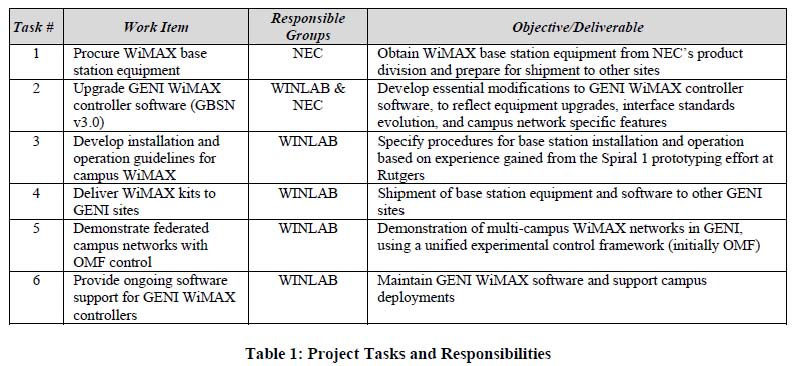
The WiMAX Kit Project (1753) established this high-level schedule:

Software releases follow this plan:
| Release | Features | Released | Delivered | Where | Note |
| v1.0 | - | Plan 10/1/09 (Spiral 1) | - | Rutgers WINLAB | For first demos and experiments |
| v2.0 (GBSN v3.0) | - | Plan 7/15/10 (Spiral 2) | - | - | For use with first delivered kits |
| v2.1 (GBSN v3.1) | - | Plan 11/2010 (Spiral 3) | - | - | - |
| v2.2 (GBSN v3.2) | - | (Spiral 4) | - | - | - |
The first sets of kit hardware were ordered in 2008 and delivered in 2009, as part of Spiral 1:
| Kit | Ordered | Received | Integrated | Delivered | Where | Note |
| 1.1 | 2008 | 2009 | 2009 | 2009 | Rutgers, WINLAB | For development |
| 1.2 | 2008 | 2009 | 2009 | 2/2010 | Rutgers, WINLAB | p/o ORBIT testbed |
The second sets of kit hardware were ordered in 2009 and will be delivered in 2010 and 2011, as part of Spirals 2 and 3.
Issue: It has been planned that three kits will be delivered during Spiral 2 (7/1/10), and the remaining four during Spiral 3. It has been planned that the first three kits will be delivered to campuses/sites where there is easy access for support, i.e., at nearby locations: Rutgers Busch Campus, Columbia University, Polytechnic Institute of NYU, and/or UMass Amherst. However, it would also make sense to deliver a kit ONLY when the campus/site has received an FCC license, and is ready to install the kit. Thus, the delivery sequence will depend on campus status.
| Kit | Ordered | Received | Integrated | Delivered | Where | Note |
| 2.1 | 12/17/09 | 4/20/10 | ? | Spiral 2 (planned 7/1/10) | Rutgers, Busch Campus | Applications |
| 2.2 | 12/17/09 | 4/20/10 | ? | Spiral 2/3 (planned 9/1/10) | Columbia University | ? |
| 2.3 | 12/17/09 | 4/20/10 | ? | Spiral 2 (planned 7/1/10) | Polytechnic Institute of NYU | ? |
| 2.4 | 12/17/09 | 4/20/10 | ? | Spiral 3 | UCLA | ? |
| 2.5 | 12/17/09 | 4/20/10 | ? | Spiral 3 | University of Colorado at Boulder | ? |
| 2.6 | 12/17/09 | 4/20/10 | ? | Spiral 2 (planned 7/1/10) | UMass Amherst | ? |
| 2.7 | 12/17/09 | 4/20/10 | ? | Spiral 3 | University of Wisconsin | ? |
A third set of kit hardware was ordered in 3/2010 and will be delivered in Spiral 1, for those campuses not included in the Spiral 2 projects, or for campuses that want to install additional kits.
| Kit | Ordered | Received | Integrated | Delivered | Where | Note |
| 3.1 | 3/10 | ? | ? | (early planned 6/1/10) | BBN Technologies | Could a kit from the second set be delivered for use until this kit is received? |
| 3.2 | 3/10 | ? | ? | ? | University of Wisconsin, 2nd site | ? |
| 3.3 | 3/10 | ? | ? | ? | ? | ? |
| 3.4 | 3/10 | ? | ? | ? | ? | ? |
| 3.5 | 3/10 | ? | ? | ? | ? | ? |
6.17 Kit Issues
| No | Issue | Who | Opened | Resolved | Resolution | Note |
| 6.1 | No. of servers in kit: Are there campuses that can complete their expected experiments operating with only one server? two servers? | Mussman, Seskar, team | - | 4/2/10 | Agreed to start with one high-capacity server, supplied by Rutgers; later, can add additional servers if more capacity neeed. | - |
| 6.2 | Federation of WiMAX testbeds: How will federation among WiMAX testbeds be accomplished? | Mussman, Seskar, team | - | - | - | - |
| 6.3 | Connection of WiMAX testbeds: How will WiMAX testbeds be connected together, using a VLAN carried by a GENI backbone? | Mussman, Seskar, team | - | - | - | - |
| 6.4 | Kit delivery sequence: It has been planned that three kits will be delivered during Spiral 2, and the remaining four during Spiral 3. It has been planned that the first three kits will be delivered to campuses/sites where there is easy access for support, i.e., at nearby locations: Rutgers Busch Campus, Columbia University, Polytechnic Institute of NYU and/or UMass Amherst. However, it would also make sense to deliver a kit ONLY when the campus/site has received an FCC license, and is ready to install the kit. Thus, the delivery sequence will depend on campus status. | Mussman, Seskar, team | - | 5/1/10 | 5/1: Current delivery sequence is: BBN; NYU Poly; Columbia and possibly UMass Amherst. | - |
| 6.5 | Kit contents: Agreed to move power supplies into category provided by Rutgers, since cost is low ($115); also, use only larger supply. | Seskar, Michel, Mussman | 2/23/10 | 2/23/10 | - | - |
| 6.6 | Kit contents: Agreed to move GPS receiver into category provided by Rutgers, since total cost is likely to be less than $125, and it should be installed at the start. | Seskar, Michel, Mussman | 2/23/10 | 2/23/10 | - | Need to engineer active antenna and cable for up to 100m, and need a BOM for active antenna, arrestor and cable. Candidate is PCTel GPS-TMG-SP-40N |
| 6.6 | GPS receiver: Need to engineer active antenna and cable for up to 100m, and need a BOM for active antenna, arrestor and cable. | Mussman | 2/23/10 | 4/10/10 | - | Chose PCTel GPS-TMG-SP-40N GPS antenna assembly with 40-dB of gain, and 200-ft of RG58C/U cable, with 40dB of loss at 1000MHz |
| 6.7 | Kamesh Namuduri: Univ North Texas interested in kit to do research | Ray | 3/16/10 | 3/16/10 | Would prefer to get existing deployment underway, and then consider a 2nd round of kits beginning in 5+ mo. | New kits would be Profile C. Expect NEC would like to see orders for 40-50, if possible |
7. WiMAX Client Platform Kit
8. WiMAX Campus Installation and Deployment
9. WiMAX Base Station Configuration
continue to Sections 1, 2 and 3
10. WiMAX Base Station Software Installation, Configuration and Operation
continue to Sections 4, 5, 6 and 7
11. WiMAX Mobile Station Configuration
12. WiMAX Site Federation
13. WiMAX Site Operations and Management
14. WiMAX Experiments and Demos
Attachments (24)
- 111309b WiMAXSystemOverview.vsd (3.8 MB) - added by 14 years ago.
- Visio-111309b WiMAXSystemOverview.pdf (741.7 KB) - added by 14 years ago.
- Visio-111309b_WiMAXSystemOverview_Page_1.jpg (258.5 KB) - added by 14 years ago.
- Visio-111309b_WiMAXSystemOverview_Page_2.jpg (231.0 KB) - added by 14 years ago.
- Visio-111309b_WiMAXSystemOverview_Page_3.jpg (397.7 KB) - added by 14 years ago.
- Visio-111309b_WiMAXSystemOverview_Page_4.jpg (931.5 KB) - added by 14 years ago.
- Visio-111309b_WiMAXSystemOverview_Page_5.jpg (542.7 KB) - added by 14 years ago.
- Visio-111309b_WiMAXSystemOverview_Page_6.jpg (496.5 KB) - added by 14 years ago.
- Visio-111309b_WiMAXSystemOverview_Page_7.jpg (360.7 KB) - added by 14 years ago.
- WiMAX Concepts and RF Measuremnts by HP WiMAX-details.pdf (983.8 KB) - added by 14 years ago.
- figure6-1networkrefmodel.jpg (46.6 KB) - added by 14 years ago.
- figure6-2asnrefmodel.jpg (33.0 KB) - added by 14 years ago.
- 113009 v0.5 GENIDandPInfraBuildouts.pdf (181.1 KB) - added by 14 years ago.
- fig1wimaxcampusbuildout.jpg (54.8 KB) - added by 14 years ago.
- fig6schedule.jpg (34.9 KB) - added by 14 years ago.
- table1projecttasks.jpg (80.5 KB) - added by 14 years ago.
- tablesiteplan.jpg (132.4 KB) - added by 14 years ago.
- tabl1campusresanditlead.jpg (64.7 KB) - added by 14 years ago.
- 041510 Quote_5018368.pdf (97.8 KB) - added by 14 years ago.
- coverletter.pdf (89.6 KB) - added by 14 years ago.
- Mobile_WiMAX-_Part_1-Overview_and_Performance.pdf (732.1 KB) - added by 14 years ago.
- Mobile_WiMAX_Part2_Comparative_Analysis.pdf (331.0 KB) - added by 14 years ago.
- 092010b GENI_WiMAX WINTECH_2010.ppt (4.3 MB) - added by 14 years ago.
- UoC - MacroMAXe RF Plan V1.1.pptx (8.6 MB) - added by 12 years ago.

